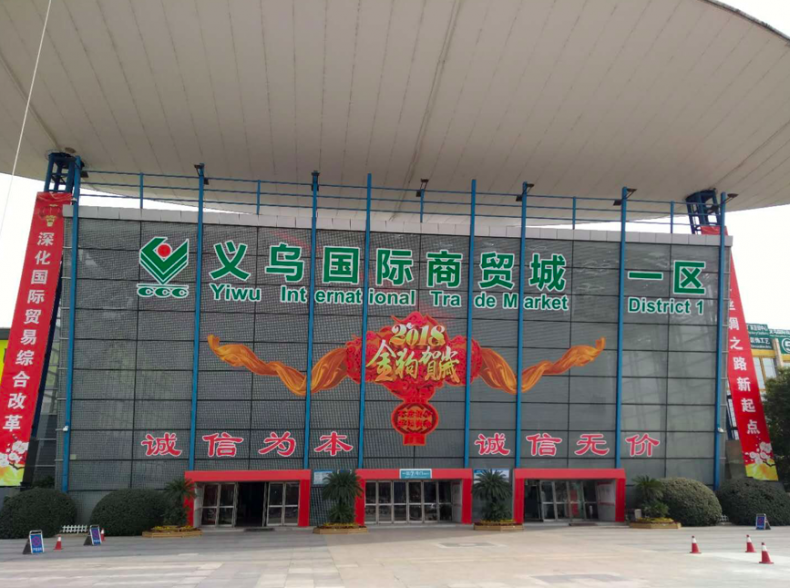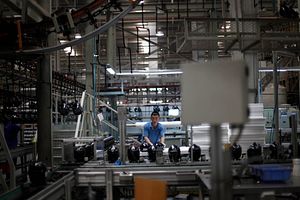At first glance you could be forgiven for thinking Yiwu, a city of close to two million people in China’s Zhejiang province, is a little sleepy. Yet, behind the façade of tree-lined boulevards, surprisingly uncongested roads, and the impressively spacious Xiuhu Park, this city is a microcosm of China’s manufacturing powerhouse and its interactions with the world. Yiwu is the home of the world’s largest wholesale consumer goods market, and attracts over 500,000 foreign traders every year, the majority coming from the Arab world. It’s easy to enjoy some baklava in one of the city’s numerous Middle Eastern restaurants and romanticize about what appears to be a modern-day equivalent of the Silk Road that once connected China with the Arab world.
Romanticizing aside, after spending some time in Yiwu’s business district reality hits home: despite rising wages, Yiwu and China’s manufacturing powerhouse are becoming still more powerful. In 2015, China’s share of global manufacturing rose to 27 percent, its highest total since records began. This is bad news for those developing countries hoping to grow through the offshoring of Chinese manufacturing.
Over the past 70 years, successful developing economies have exploited their low-cost labor comparative advantages to draw in foreign investment and develop their manufacturing sectors during early stages of growth. As wages rose due to labor shortages, these manufacturing industries then relocated to economies with even cheaper wages, while the economy which initially shed the jobs moved up the value chain into more sophisticated industries. Professor Justin Lin, former Chief Economist of the World Bank, has argued that this growth pattern has been a recurring theme, whether in Japan, South Korea, Singapore, Taiwan, Hong Kong, or China.
Between 2005 and 2016, Chinese manufacturing wages trebled; as they continue to rise, the question is, will jobs continue to relocate abroad? Already some of China’s manufacturing jobs have been relocated to countries including Vietnam, Cambodia, and Ethiopia. However, much of China’s manufacturing sector — employing 85 million people — remains intact.

The International Trade Market in Yiwu, Zhejiang Province in China. It is the largest wholesale consumer goods market in the world. Photo by Ravi Prasad.
As a city that exported $37 billion in 2017 – about the annual GDP of Bahrain – Yiwu stands to lose out if rising wages reduce export potential. Yet, three key trends in Yiwu and more broadly in China are ensuring that China’s manufacturing sector retains and expands on its existing dominance.
First, supply chain efficiency, logistics, and infrastructure are becoming more important for manufacturing sector success. As a recent World Bank publication notes, manufacturers are increasingly competing in these areas as opposed to in lower wages. China has already built up a reliable ecosystem incorporating these factors, but recently renewed its efforts to invest and upgrade in them. In Yiwu’s case, a $1.5 billion fund has been created to invest in logistics infrastructure across railways, roads and trade zones. Access to key export markets has been improved through the construction of railway lines from Yiwu to Madrid and London — reducing delivery times by up to 20 days versus shipping. At the same time, Chinese logistics companies are investing aggressively abroad and solidifying their global networks. In the first 11 months of 2017, Chinese logistics companies invested $32.2 billion overseas – a 250 percent increase on 2016. And it’s not just hard infrastructure that’s being invested in, China’s growing online retail presence is good news for foreign traders not wanting to travel afar. Yiwu, for example, has 255,000 online retailers, more than three times the number of its offline retail stores.
Having such a reliable ecosystem built through decades of experience and continued investments makes importers more reluctant to source from other countries. Indeed, ask any foreign trader in Yiwu why they still travel there and they will invariably tell you that the Chinese ecosystem is best-in-class. Individual retailers in Yiwu’s International Trade Market can tailor items according to the customer’s needs, complete all paperwork, and organize delivery. They can do that with some of the shortest lead times globally. It is going to be a arduous task for any developing country to compete with the quality and size of China’s manufacturing sector ecosystem.
Second, recent advances in automation and artificial intelligence are making manufacturing less dependent on low-cost labor. Companies based in China are concerned about losing their competitive advantage and consequently are investing heavily in these new technologies. For example, Foxconn announced in 2016 that it was introducing 40,000 robots into a mainland Chinese factory to replace 60,000 workers. A recent study of 640 Chinese manufacturing firms found that the most common response to rising wages was to invest in technological upgrading. In contrast, only 6 percent of firms identified relocation of operations as their preferred response. As a result, given the technological backdrop, China’s manufacturing sector can entrench its existing advantages despite rising wage pressures and retain jobs in a way that would not have been possible in past decades.
Third, in addition to being the key dominant global producer of many manufactured goods, China is becoming an important consumer. In 2015, China was responsible for over a quarter of global manufacturing output but only 10 percent of global consumption. Yet the latter statistic represents an increase from 3 percent in 2000. Factory owners in Yiwu say this rapid shift has caused them to increasingly look inwards in search of topline growth. Chinese factories are best positioned to serve the Chinese consumer given proximity, familiarity, and an ability to adapt quickly to evolving consumer preferences. This “near-sourcing” in turn reaffirms the longevity of the Chinese manufacturing powerhouse as it will be able to tap into its growing domestic market for many years to come.
These three forces combined – China’s advanced and constantly improving manufacturing sector ecosystem, the push for automated processes, and the desire to near-source given the rising importance of the Chinese consumer – are making China’s manufacturing powerhouse even more powerful. It means that Chinese factories will be harder to displace, even if other countries are offering lower wages. This presents significant risks for developing countries premising their growth strategies on securing manufacturing jobs being transferred from China. Those countries are investing in infrastructure today, with the hope that manufacturing jobs will come tomorrow. But if the changing landscape in Yiwu and China’s manufacturing powerhouse are anything to go by, there is a risk that those manufacturing jobs may never come.
Ravi Prasad is a Yenching Scholar at Peking University and Research Associate at the Institute for New Structural Economics in Beijing. He is the founder of www.beltandroad.blog. He has previously written for a range of publications including The Diplomat, CCTV, and The Times.

































